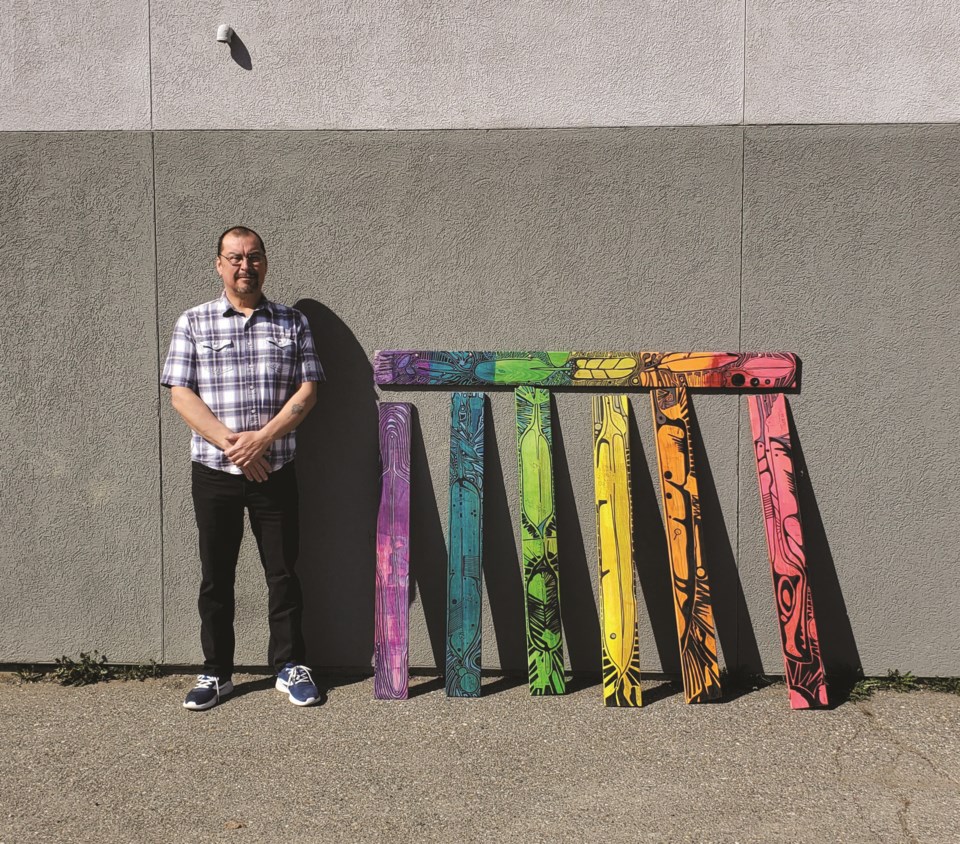James Darin Corbiere’s resumé might seem like an eclectic collection of unrelated careers, but when you hear his life story, you realize there’s actually a neat line connecting it all.
From policeman to language teacher to writer and artist, Corbiere (or Waab Shki Makwa) has brought the same (sometimes secretly) subversive approach to each of those roles.
“I experienced church violence as a child, put it that way,” says Corbiere, who is Anishinaabe from Wiikwemkoong First Nation, Manitoulin Island, Ont. “As I get older now, I look back and reflect on all these things that have happened to me in my life and how it changed or it sculpted or created my life up until now. Because I was always afraid, I became a police officer. My experience in policing was to make sure that people were taken care of. That was my philosophy.”
He was not an enforcer, nor did he agree with the tactic of handing out tickets to meet quotas. After moving back to his home reserve to work as an officer for one year, his position was terminated.
So, Corbiere decided to attend university, where he earned a degree in biology and trained to be a teacher.
While he wasn’t certified as a language teacher, he was hired in Sault Ste. Marie.
“My understanding of the Anishinaabe language isn’t the best—I would probably say I’m 25-per-cent literate in terms of the language,” he says. “But that’s 25 per cent more than most people have.”
Of course, growing up with the language, Corbiere also understood the nuances and pronunciation of many words as well.
“I became a language teacher and I tried to infuse Indigenous philosophies wherever I could,” he says. “One of the things I like to say is that I tried to decolonize things in secret. The police, the justice system, I wasn’t an enforcer. And in the classroom I wasn’t big on exams or performance assessments, things like that. I was more interested in ‘what did you learn?’ not ‘what did you remember that you can regurgitate on an exam?’”
As part of that job, Corbiere found himself delving into the , which are plastered all over classrooms in Canada, highlighting love, honesty, courage, truth, humility, respect and wisdom.
But the version of those teachings people most encounter is Westernized, and different than the original, which was created by Corbiere’s ancestors.
“When we break down the words according to the feeling or the ideas that are contained within those words, it has a completely different meaning than what we would expect,” he says.
One example: honesty. His students would often define that as “not to tell a lie.”
“Yes, that’s correct, but what does it mean in terms of the depth or idea behind it? So what I’ll do is go to the word, which is gwayakwaadiziwin. And I break down each of those components. A lot gets lost in translation, but when you see the bigger picture, it’s a better understanding of what honesty really means,” he says.
Corbiere is now set to take his lessons on the Seven Sacred Teachings—condensed from weeks in the classroom into 45 minutes—and share them with the public in-person for the first time at the Maury Young Arts Centre as part of this month’s .
“We’re talking about some simple concepts that will help with the relationships that you have, not just with other people, but with the earth, with the animals and all the other things that are around us,” he says.
But that session is just one project Corbiere, now based in Cowichan Bay, is working on.
In 2015, after turning 50, he decided to go on a fast quest—which men typically embark upon in their teen years—in search of his purpose. In his youth, he had been able to see colours around people, but that had long been stamped out.
His vision during this journey: a sasquatch, sitting on a rock, saying “underneath here, there’s treasure, but you’re going to have to work hard, you’re going to have to really dig to get to it.”
Corbiere interpreted that as digging through his childhood trauma. A month later, that manifested in him wanting to build a boat like the kind elders in his community would set out on to go fishing.
“One night, I came home and I had a pen in my pocket and I had some of this wood out in my basement. I went into a flashback. At some point, I must have smashed a few things. Sometimes, that’s what I do. But the pen broke and the ink leaked onto this chunk of an ash that was laying there. That would be a defining moment, because that’s when these images started to appear, the lights turned back on so to speak. That basically began my artwork.”
Corbiere has continued working on white ash with various types of ink, but he’s also created a graphic novel and a game based on Truth and Reconciliation.
“The artwork was a way for me to get rid of all the stuff I was carrying inside, to let a lot of that go,” he says. “There’s still stuff there, plastered to the walls that I’ve got to scrape off, but generally speaking the artwork has been cathartic and healing.”
Looking ahead, he hopes to add more videos like the A Better Understanding of the Seven Sacred Teachings to his YouTube as well.
“I’m looking forward to coming up [to Whistler] to do this presentation,” he adds. “This is the first in-person presentation I’ve done on these teachings to an audience like this … I’m really excited about that.”
A Better Understanding of The Seven Sacred Teachings takes place on Thursday, Sept. 15 at the Maury Young Arts Centre. Tickets are $10 with the night including a musical performance from Willie Thrasher and Linda Saddleback.
Get them at .
For more on Corbiere’s art, visit .


